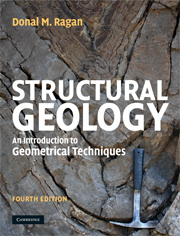Book contents
- Frontmatter
- Contents
- Preface
- Acknowledgements
- 1 Structural planes
- 2 Thickness and depth
- 3 Lines and intersecting planes
- 4 Planes and topography
- 5 Stereographic projection
- 6 Rotations
- 7 Vectors
- 8 Faults
- 9 Stress
- 10 Faulting
- 11 Deformation
- 12 Strain
- 13 Flow
- 14 Folds
- 15 Parallel folds
- 16 Similar folds
- 17 Folds and topography
- 18 Structural analysis
- 19 Tectonites
- 20 Drill hole data
- 21 Maps and cross sections
- 22 Block diagrams
- Appendices
- References
- Index
7 - Vectors
Published online by Cambridge University Press: 05 June 2012
- Frontmatter
- Contents
- Preface
- Acknowledgements
- 1 Structural planes
- 2 Thickness and depth
- 3 Lines and intersecting planes
- 4 Planes and topography
- 5 Stereographic projection
- 6 Rotations
- 7 Vectors
- 8 Faults
- 9 Stress
- 10 Faulting
- 11 Deformation
- 12 Strain
- 13 Flow
- 14 Folds
- 15 Parallel folds
- 16 Similar folds
- 17 Folds and topography
- 18 Structural analysis
- 19 Tectonites
- 20 Drill hole data
- 21 Maps and cross sections
- 22 Block diagrams
- Appendices
- References
- Index
Summary
Introduction
Vectors play a prominent role in many geometrical and physical applications. We have seen several simple examples in Chapters 1 and 3 where the attitudes of planes and lines were represented and manipulated using two-dimensional vectors. We now extend the treatment to three dimensions, and to several additional applications.
As we have seen, the stereonet is a useful way of displaying and manipulating structural lines and planes easily and directly in a three-dimensional setting. For the same reasons, we can use the stereonet to introduce an analytical approach involving vectors which is a powerful method for solving these same types of problems (see also Sprenke, 1992).
Because the orientations of planes are defined by their poles, we can represent all structural elements by lines. There are two types of such lines.
Axes have orientation but no sense. Lineations in metamorphic rocks, lines of intersection and poles of fracture planes are examples.
Vectors have both orientation and sense. Examples include some linear sedimentary structures and paleomagnetic directions.
Some structural lines may be treated in either way. For purely geometrical purposes the pole of sedimentary bedding is commonly treated as an axis, but for other purposes the pole in the direction of younging has sense and therefore is a true vector.
- Type
- Chapter
- Information
- Structural GeologyAn Introduction to Geometrical Techniques, pp. 130 - 164Publisher: Cambridge University PressPrint publication year: 2009
- 1
- Cited by

